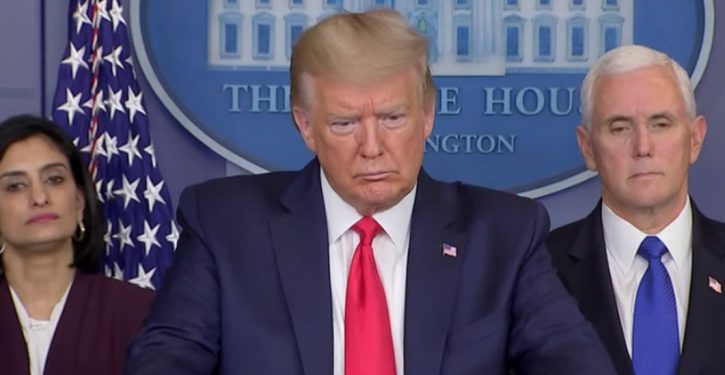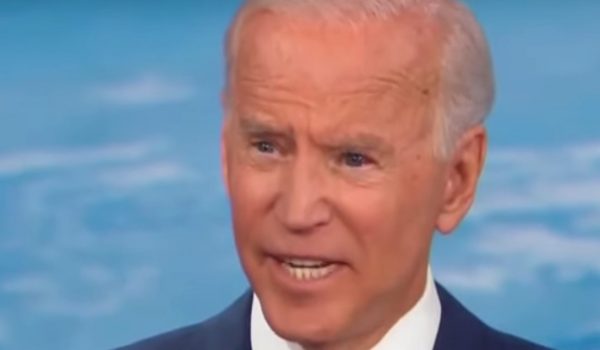
In the White House press briefing on Wednesday, President Trump referred to the COVID-19 coronavirus as the “Chinese virus.” (He also tweeted an allusion to the “Chinese virus.”)
Now, probably, if Trump merely referred to it as “the coronavirus,” which is the way the vast majority of people refer to it colloquially, since we all know which coronavirus we’re talking about, he would have been excoriated for not being more precise. A “coronavirus” is a class of virus, and there are a number of specifically identified variants of it. The virus stalking the globe at the moment is formally named COVID-19.
Trump would be called names and raked over the coals by the media no matter what he did. If he called the virus COVID-19, he’d be ridiculed for pronouncing it funny. So let’s not pretend any of this is about precision, accuracy, or righteous causes.
But instead of using the colloquial default term – coronavirus – he called it the “Chinese virus.” My ear detected a slight emphasis on that in his opening comments. Readers who disagree should feel free to drop by in the Comments section and make their case.
I’m not condemning Trump for the slight emphasis. I’m mentioning it, to clarify that I don’t suggest he had nothing in mind by saying it.
I think he did. That said, there’s nothing mean-spirited, sneaky, convoluted, or subtle going on here. It’s not a slam on China or Chinese people. Nor is it communication as 4-D chess. Trump was doing something very simple and direct.
What he was doing is easily discernible from the few words he actually spoke, when asked about saying “Chinese virus.” It’s no more complicated than that. Just listen. (Video below.)
Starting at 42:48:
Reporter: Why do you keep calling this the “Chinese virus”? There are reports of dozens of incidents of bias against Chinese Americans in this country; your own aide, Secretary Azar, says he does not use this term, because ethnicity does not cause the virus. Why do you keep using this? A lot of people say it’s racist.
Trump: Because it comes from China. It’s not racist at all, no. Not at all. It comes from China. That’s why. It comes from China. I want to be accurate.
[POTUS prepares for next question as reporter persists with partly inaudible words about “Chinese” and what sounds like “hate.” POTUS then resumes.]
I have great love for all of the people from our country, but, uh, as you know, China tried to say, at one point – maybe they’ve stopped now – that it was caused by American soldiers. That can’t happen. That’s not gonna happen. Not as long as I’m president. It comes from China.
That’s it. Later in the Q&A, Trump was asked similar questions again, at the 1:06:00 mark and again starting at 1:14:50 (the “kung flu” passage, citing another journalist who claimed someone spoke this term to her at the White House).
This morning a White House official referred to #Coronavirus as the “Kung-Flu” to my face. Makes me wonder what they’re calling it behind my back.
— Weijia Jiang (@weijia) March 17, 2020
After the reporter (Yamiche Alcindor of PBS NewsHour) belabored “kung flu” for a few seconds, Trump responded to the following question:
Reporter: Do you think using the term “Chinese virus” – that puts Asian Americans at risk –
Trump: No –
Reporter: … that people might target them?
Trump: Not at all. Not at all. I think they probably would agree with it 100%. It comes from China. There’s nothing not to agree with.
Trump is just speaking up for the truth – truth that the regime in Beijing now seeks to undermine.
The virus emerged from China. Claiming outraged ethnicity doesn’t change that. Saying the virus emerged from China doesn’t imply that “ethnicity caused the virus”; that’s a straw man. It’s meant to obfuscate our thinking and weaken our clear understanding of the truth, thereby softening us up for the Chinese government’s absurd allegation that the U.S. military infiltrated China with the novel coronavirus.
Trump addressed those points not by analyzing the straw man attack, but by simply asserting the truth with the term “Chinese virus,” and repeating that “it comes from China.”
As a tactic, this simplicity is very effective. Trump doesn’t engage the straw man. He just unwaveringly reiterates his own point.
His point is correct, which make it easier. The virus emerged in China. The Chinese leadership may seek to create an impression of doubt about that, but Trump is not going to play along – something he would, in effect, be doing, if he gave the “outraged ethnicity” straw man the time of day.
In the last 30 years or so, probably 95% of political discourse in the West has been about engaging with straw men, which is one very big reason why the people have been so extremely ill-served by it. Simply stating the truth now sounds harsh and alarming to too many ears.
But Trump doesn’t talk in that defensive, straw-man-engaging way. That’s why he got elected in 2016. The longer we see him at work, the clearer it is that he is not speaking merely for himself in these communication dust-ups. He is defending speech itself, as a method of stating positions in dialogue – as opposed to a highly manipulable method of silencing and defaming others – on behalf of the American people who elected him.
Contrast Trump’s directness with the knots the media tie themselves in trying to make persuasive cases out of illogic:
.@RichardEngel: "This is a virus that came from the territory of China but came from bats. This is a bat virus, not a China virus. It doesn't speak Chinese. It doesn't target Chinese people. It targets human beings who happen to touch their eyes, nose or mouth." pic.twitter.com/ljQeT7UQam
— MSNBC (@MSNBC) March 18, 2020
That one’s hard to beat. At any rate, the principles of political dialogue Trump in effect defends are these:
Truth won’t be silenced by outrage.
The people’s speech won’t be suppressed by outrage.
The most outraged (or the first to claim outrage) won’t own the narrative.
“Cancel culture” won’t work here.
Q: "The president continues to call this the 'Chinese virus.'"@LindseyGrahamSC: "It is, it came from China."
Q: "You think it's ok for him to say that?"
Sen. Graham: "Yeah, I do." pic.twitter.com/iojlz6s9S1
— Benny Johnson (@bennyjohnson) March 19, 2020
The media will lose the battle to establish that it’s “racist” to acknowledge that COVID-19 emerged in China. That will be because Trump said, very simply, “Chinese virus,” and “it comes from China.”
There are Never Trumpers who desperately wish that it were otherwise, but the reality is that no other method – however collegial, however self-consciously ponderous and consensus-seeking, however determined to credit bad faith with good – no other set of forms or protocols has been actually working, these past 30 years, in the battle to defend the truth. Trump, in a way similar to Reagan, makes political opponents fight over the truth on his turf. That’s what his supporters see as a feature, where others see it as a bug.



